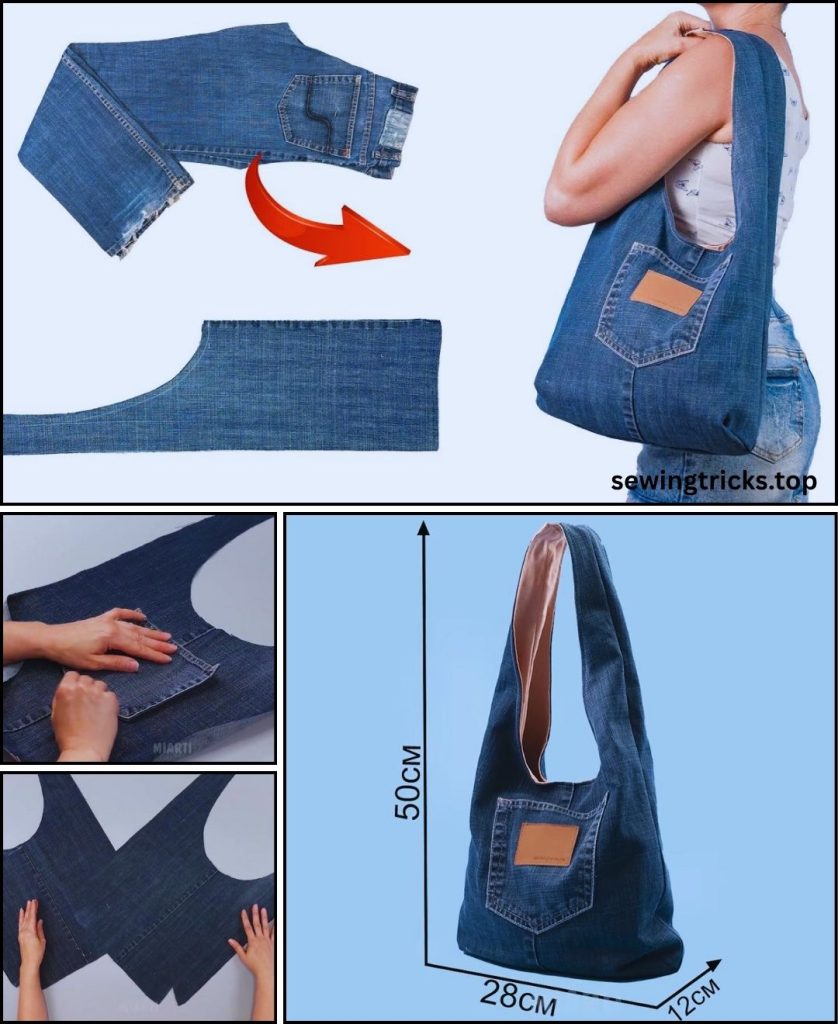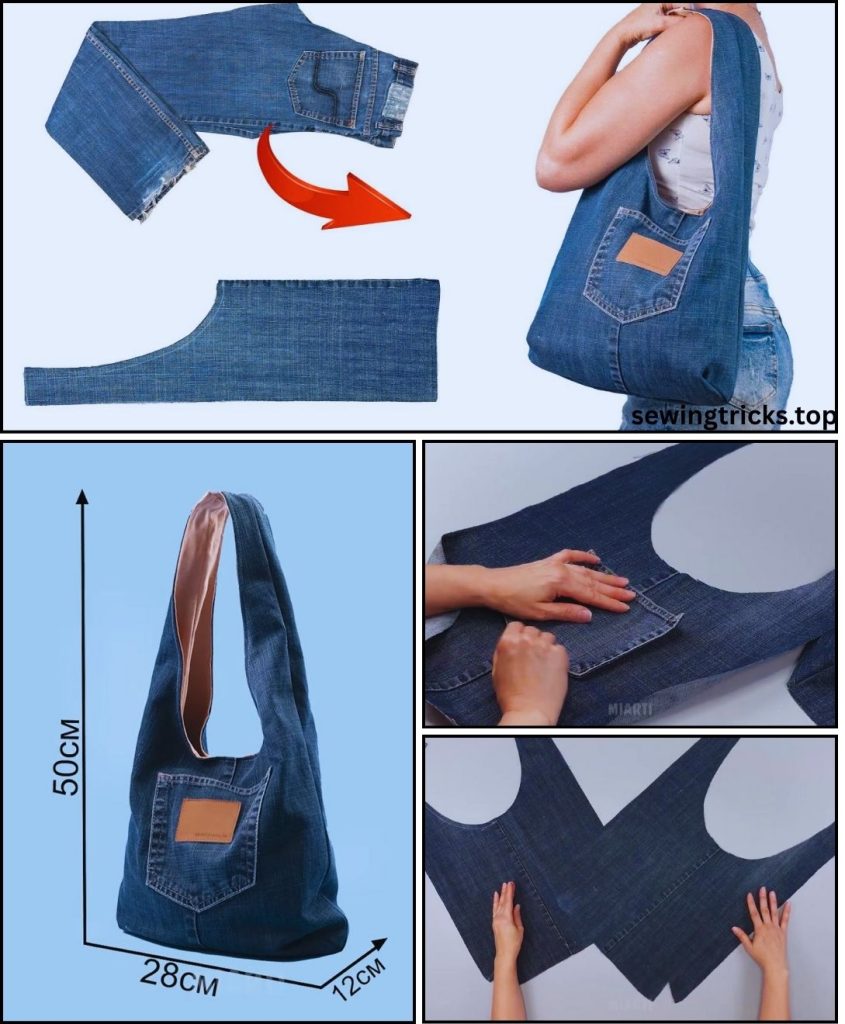Upcycling old jeans into a stylish and sturdy tote bag is an excellent project for sewing beginners! Denim is naturally durable, and by using the existing structure of the jeans (like the waistband and pockets), you save time and achieve a unique, professional look.
This detailed tutorial will guide you through creating a classic, lined tote bag with a flat, structured bottom. We’ll aim for a finished size of approximately 14 inches wide, 12 inches tall, and 4 inches deep, a perfect size for groceries, books, or daily essentials.

I. Planning & Gathering Your Materials
Careful preparation will ensure your bag is both beautiful and functional.
- Old Jeans:
- Quantity: 1 pair of adult-sized jeans (preferably non-stretch or low-stretch denim for better structure).
- Preparation: Wash and thoroughly dry the jeans. Unpick the seams to get the largest possible flat pieces of denim for the bag body.
- Lining Fabric:
- Quantity: 1 yard of woven cotton, like quilting cotton or broadcloth.
- Preparation: Wash and iron.
- Interfacing (Recommended for Structure):
- Quantity: 1 yard of medium-weight fusible interfacing. This gives the denim more body.
- Webbing for Handles:
- Type: Cotton or polypropylene webbing, 1 inch wide.
- Quantity: Two pieces, each 26 inches long.
- Matching Thread:
- All-Purpose Thread: For lining.
- Heavy-Duty/Topstitching Thread: In a contrasting color (like gold or yellow) for attaching handles and topstitching.
- Basic Sewing Tools: Sewing machine (use a new denim needle, size 16 or 18), sharp scissors or rotary cutter, ruler, fabric marker, and plenty of fabric clips (denim is often too thick for pins).
II. Prepare & Cut Your Fabric Panels
Accuracy in cutting and fusing interfacing is paramount for a professional finish.
1. Cut Main Bag Panels (Denim & Lining)
- From your Denim (Exterior Fabric):
- Main Exterior Panels: Cut two rectangles, each 15 inches wide x 13 inches tall.
- Optional: Harvest a back pocket from the jeans for an exterior pocket, leaving about a 1/2-inch seam allowance around the edges.
- From your Lining Fabric:
- Main Lining Panels: Cut two rectangles, each 15 inches wide x 13 inches tall.
- Fuse Interfacing: Fuse the medium-weight interfacing to the wrong side of both your denim exterior panels and both your lining panels (following manufacturer instructions).
2. Prepare Handles and Pockets
- Cut two pieces of webbing, each 26 inches long.

III. Step-by-Step Sewing Instructions
Use your denim needle and maintain a consistent 1/2-inch seam allowance unless otherwise stated.
1. Add Exterior Pocket (Optional)
- Take one of your Main Exterior Panels. Lay it right side up.
- Position the harvested back pocket where you’d like it. Pin it securely.
- Stitch the pocket onto the denim panel, very close to the existing stitched edges of the pocket. Reinforce the top corners with a small triangle or bar tack stitch using your heavy-duty thread.
2. Attach Handles
- On the same Main Exterior Panel (with pocket, if added), measure 4 inches in from each side edge along the top raw edge. Mark these points.
- Place the raw ends of one webbing handle onto these marks, aligning the raw edge of the webbing with the raw top edge of the panel. The handle loop should face downwards onto the bag body.
- Stitch the handle in place with a strong reinforcing stitch (e.g., a box stitch with an “X” inside it) using your heavy-duty thread, securing it within the 1/2-inch seam allowance.
- Repeat for the second handle on the second Main Exterior Panel.
3. Assemble the Exterior Bag
- Take the two Main Exterior Panels and align them right sides together.
- Pin the side seams and the bottom seam. Sew with a 1/2-inch seam allowance.
- Create boxed corners: This gives your bag a flat, structured bottom. At each bottom corner, pinch the side seam and the bottom seam together, aligning them to form a triangle. Measure 2 inches down from the corner tip and mark a straight line across. Sew along this line.
- Trim the excess fabric from the corner, leaving a 1/2-inch seam allowance. Repeat for the second corner.

4. Assemble the Lining Bag
- Follow the same steps as in Step 3 to assemble the two Main Lining Panels and create the boxed corners.
- Crucially, leave a 5-6 inch opening in the middle of the bottom seam. This is the hole you will use for turning the bag right side out.
5. Combine and Finish the Bag
- Turn the denim exterior bag right side out.
- Keep the lining bag inside out.
- Carefully insert the denim bag into the lining bag, so that their right sides are facing each other. The handles should be tucked down between the layers. Align the side seams and the top raw edges. Pin or clip all the way around the top opening.
- Stitch all the way around the top with a 1/2-inch seam allowance.
- Turn and close: Pull the entire bag right-side out through the opening you left in the lining’s bottom seam. Push out the corners and seams. Press the seam allowances of the opening in the lining under and stitch it closed by hand or machine.
- Push the lining into the bag. For the final touch, topstitch around the entire top opening of the bag, about 1/4 inch from the edge, using your heavy-duty thread. This gives the bag a crisp, professional finish and helps the top hold its shape.
Congratulations! You’ve successfully sewn a durable and unique denim tote bag from old jeans.




